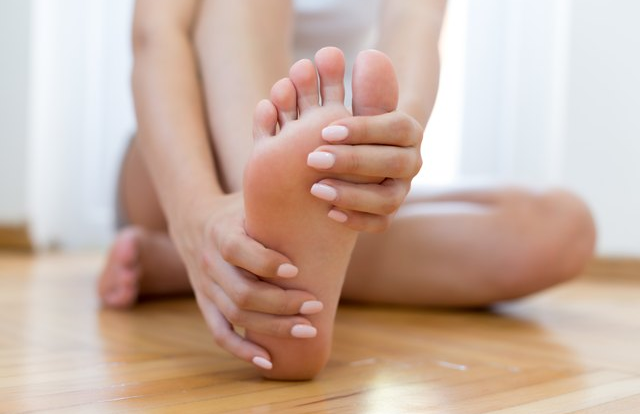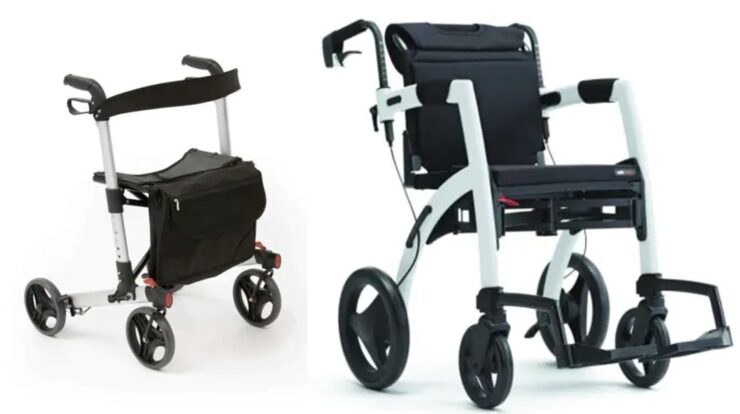
Pain on the bottom of your foot, often in the heel or arch, can make walking and standing uncomfortable. The cause could be anything from wearing unsupportive shoes to conditions like plantar fasciitis or muscle strain.
Fortunately, there are several easy, effective ways to relieve this type of foot pain. Here’s a look at some tried-and-true remedies you can try to ease the pain and keep your feet comfortable.
1. Stretching Exercises
Stretching the foot can be incredibly effective for relieving pain, especially if it’s centered around the arch or heel.
- Toe Stretches: Sit down and place one leg over the other. Using your hands, gently pull your toes back toward your shin until you feel a stretch in your arch and heel. Hold for about 10 seconds, and repeat a few times on each foot. This stretch can be especially helpful if you have plantar fasciitis.
- Calf Stretch: Tight calf muscles can contribute to foot pain. Stand facing a wall, place one foot behind the other, and press your back heel into the ground while leaning forward. Hold for 10-15 seconds and switch sides.
Stretching helps release tension in your foot muscles and tendons, which can relieve pressure and ease pain.
2. Massage for Foot Pain Relief
A massage can do wonders for sore feet, especially if the pain is in the arch or heel. Massaging improves blood flow, reduces tightness, and offers quick pain relief.
- Tennis Ball Roll: Place a tennis ball (or a frozen water bottle if you prefer a cooling effect) on the ground, and gently roll it under your foot. Start at the heel and move toward the toes, applying light pressure. This rolling motion massages the plantar fascia, the band of tissue under your foot that can often cause pain.
- Thumb Massage: Use your thumbs to apply gentle pressure to the bottom of your foot, working in small circles along the arch and heel. Spend a few minutes on each foot, focusing on areas where you feel pain.
Massage helps to loosen up tight muscles and provide targeted relief to painful areas.
3. Try a Foot Soak
A warm foot soak is relaxing and can help reduce inflammation and tension in the muscles and tendons.
- Epsom Salt Soak: Epsom salt contains magnesium, which is known to reduce inflammation. Add about half a cup of Epsom salt to a basin of warm water and soak your feet for 15-20 minutes. Epsom salt can ease pain and soften skin, making it a perfect remedy for sore feet.
- Baking Soda and Warm Water: Baking soda can help soothe sore feet and reduce odors. Mix a few tablespoons of baking soda in warm water and soak for about 15 minutes.
Foot soaks relax the muscles and allow you to unwind after a long day, leaving your feet refreshed.
4. Ice Therapy for Inflammation
If your foot pain is due to inflammation or swelling, ice therapy can provide quick relief. Cold temperatures reduce blood flow to the area, which minimizes swelling and numbs pain.
- Ice Pack: Wrap a few ice cubes in a thin towel, and place it on the painful part of your foot for about 10-15 minutes. You can also use a frozen bag of peas if you don’t have ice cubes.
- Frozen Water Bottle Roll: Fill a small water bottle with water and freeze it. Roll the frozen bottle under your foot, focusing on the areas that hurt the most. This combines ice therapy with massage, giving you double the relief.
Make sure not to place ice directly on your skin to avoid frostbite.
5. Supportive Footwear and Inserts
Wearing supportive shoes and using inserts can prevent and relieve pain on the bottom of your foot by cushioning and stabilizing your foot.
- Arch Support Inserts: Inserts with good arch support reduce stress on the foot, especially if you have flat feet or high arches. You can find these at most pharmacies, or you can have custom inserts made by a podiatrist.
- Shoes with Cushioning: Look for shoes with thick, cushioned soles that support the natural shape of your foot. Avoid flat or unsupportive shoes, like flip-flops or ballet flats, which can worsen foot pain over time.
Proper footwear can make a huge difference in managing and preventing foot pain.
6. Foot Taping Techniques
Foot taping can stabilize the foot, relieving stress on sore areas, particularly for conditions like plantar fasciitis.
- How to Tape: Using sports tape, start at the ball of your foot and wrap it around the arch. Cross the tape at an angle, creating a supportive “X” shape under the arch. Wrap another strip horizontally around the middle of the arch to secure the tape in place.
Taping the foot this way offers added support to the plantar fascia, relieving pressure and helping prevent further injury.
7. Anti-Inflammatory Foods and Hydration
Foot pain, especially due to inflammation, can also be managed through your diet. Anti-inflammatory foods and hydration can reduce swelling and pain in the long term.
- Foods to Try: Include foods rich in omega-3 fatty acids, like salmon, flaxseeds, and walnuts, as well as antioxidant-rich fruits and vegetables, like berries, leafy greens, and citrus.
- Stay Hydrated: Drinking enough water keeps your muscles and joints lubricated, which can help prevent cramps and soreness in your feet.
A balanced diet can support muscle recovery and reduce inflammation, helping to keep your feet pain-free.
8. Rest and Elevate
Sometimes, the best remedy is simply giving your feet a break. If your foot pain is due to overuse or strain, rest is crucial for healing.
- Elevation: Lie down and elevate your feet on a pillow so they’re above your heart. This position improves blood flow and reduces swelling.
- Limit Activity: Avoid activities that put a lot of strain on your feet, like running or standing for long periods, until the pain subsides.
Taking time to rest allows your feet to recover fully and prevents the pain from becoming a recurring issue.
When to See a Doctor
While most foot pain can be managed with home remedies, certain cases might need professional attention.
If your pain is severe, persists for more than a few days, or comes with symptoms like numbness or swelling that won’t go away, it’s best to see a doctor or podiatrist.
Foot pain can be challenging, but with these remedies, you can quickly find relief and get back to your daily activities comfortably.
Incorporating stretches, massages, supportive footwear, and healthy habits into your routine can make a big difference in how your feet feel every day.






